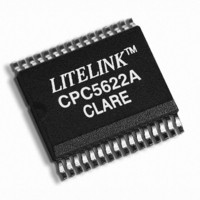CPC5622ATR Clare, CPC5622ATR Datasheet - Page 17

CPC5622ATR
Manufacturer Part Number
CPC5622ATR
Description
LITELINK III PHONE LINE 32SOIC
Manufacturer
Clare
Series
LITELINK® IIIr
Specifications of CPC5622ATR
Function
Data Access Arrangement (DAA)
Number Of Circuits
1
Voltage - Supply
3 V ~ 5.5 V
Current - Supply
9mA
Power (watts)
1W
Operating Temperature
-40°C ~ 85°C
Mounting Type
Surface Mount
Package / Case
32-SOIC (7.5mm Width)
Includes
CID Monitoring, Full-Wave Ring Detector, Half-Wave Ring Detector
Operating Temperature (min)
-40C
Operating Temperature Classification
Industrial
Operating Temperature (max)
85C
Package Type
SOIC
Rad Hardened
No
Lead Free Status / RoHS Status
Lead free / RoHS Compliant
Interface
-
Lead Free Status / Rohs Status
Compliant
Other names
CLA322TR
CPC5622ATR
CPC5622ATR
Available stocks
Company
Part Number
Manufacturer
Quantity
Price
Company:
Part Number:
CPC5622ATR
Manufacturer:
Maxim
Quantity:
2 078
Escape Sequences
An escape sequence is one or more particular characters
sent from the terminal to the modem during the On-Line
state. This is done to switch the modem to the command
state so modem commands may be entered during a
telephone line connection. The Escape Sequence char-
acters are typically sent to the other modems as data.
An escape sequence should not occur accidentally dur-
ing an exchange of data between two modems.
Unfortunately, it is impossible to guarantee any escape
sequence will never occur naturally since there are no
restrictions on the data or timing between characters
sent between two modems during the On-Line state.
The only method of switching form the On-Line state to
the Command state that does not ever occur naturally
during an exchange of data is the Data Terminal Ready
signal (the &D1 command). The terminal has complete
control of this signal and it is not part of the data
exchanged between the modems.
The Hayes escape sequence was adopted by many
modem manufacturers and communication programs
before Hayes was granted a patent for the escape
sequence guard times. Now the unpatented Time
Independent Escape Sequence (TIES) has gained pop-
ularity with many modem manufacturers.
TIES Escape Sequence
TIES stands for Time Independent Escape Sequence.
TIES was developed by a number of modem manufac-
turers in response to Hayes enforcing patent rights for
their escape sequence guard time patent.
The Time Independent Escape Sequence is a sequence
of 3 escape characters (+ characters by default). Once
these characters have been recognized, the modem
enters the Command state without sending a confirming
result code to the terminal and the modem starts a
prompt delay timer.
Then:
a. If one of the recognized AT commands is received
before the timer expires, the timer is stopped, the com-
mand is executed and its result code is sent to the ter-
minal.
b. If any other data is received while the timer is running,
the timer is stopped, the modem returns to the On-Line
state and the received data is sent to the other modem.
c. If the timer expires, a confirming result code is sent to
the terminal, indicating the modem is in the Command
state. The escape character can be changed through
Rev. 2
www.clare.com
S-Register S2. The prompt delay timer can be changed
(in 1/50 second increments) through S-Register S12
(see S-Registers section).
After handshaking, the modem determines if a tele-
phone line connection exists by detecting the carrier sig-
nal from the other modem. If the carrier is not detected
for a long enough period of time, the modem assumes
the telephone line connection with the other modem has
been broken. The modem uses S-register S9 to deter-
mine how long a carrier must be present before it is
“detected.” The modem uses S-register S10 to deter-
mine how long a carrier may not be detected before the
telephone line is hung up.
Carrier Detection
CPC2400E
17















